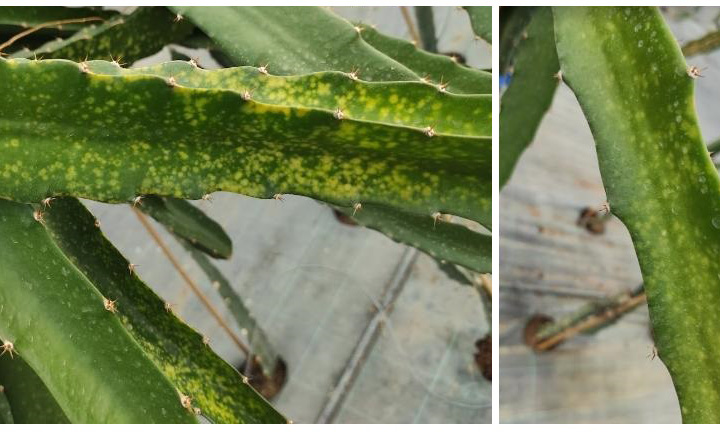Authors: Dirk Janssen, Carmen Garcia and Leticia Ruiz. Andalusian Institute of Agricultural and Fisheries Research and Training (IFAPA), La Mojonera, Spain
Photos provided by Dirk Janssen
Dragon fruit (Hylocereus undatus) is a high-value fruit crop, introduced about a decade ago in the mainland of Spain. In 2021, suspicious chlorotic spots were observed for the first time on young cladodes in a commercial dragon fruit orchard in the province of Seville (southern Spain) (click image to enlarge).
[envira-gallery id=”20300″]
There were no previous records of virus infections in dragon fruit in Europe, but worldwide, several tobamoviruses and potexviruses are know to infect this crop.
Total RNA was extracted from all 4 symptomatic cladodes and was subjected to RT-PCR with general tobamovirus and potexvirus primers. The former did not produce results. Potexprimers yielded an amplicon of the expected size which were subsequently sequenced. All showed identical sequence results (GenBank Accession MZ614940) with a predicted amino acid identity of 99% with the corresponding RNA-dependent RNA polymerase amino acid sequence of Schlumbergera virus X (SchVX) (GenBank Accession No. ACD99908). Then we designed specific SchVX primers based on the new sequence, and amplified the expected amplicon of from the total RNA extracts of the four samples. The amplicons were Sanger-sequenced and the expected nucleotide sequence was obtained. This pair of primers were used in RT-PCR tests on subsequent surveys in 2 commercial dragon fruit greenhouses from the province of Seville, and in 2 experimental greenhouses in the province of Almeria. All samples from 25 symptomatic plants of H. undatus, H. hybridum, H. costaricensis, and H. purpusii in Seville and from 2 symptomatic H. undatus plant from Almeria tested positive for SchVX, while 15 asymptomatic plants tested negative.
The results obtained in this investigation support that SchVX is present in the cladodes of dragon fruit plants expressing the symptoms. SchVX has been reported previously from H. undatus from Brasil and from prickly pear in Mexico, and to our knowledge, this is the first report of the virus in Spain. These findings suggest that SchVX has been introduced in dragon fruit farms from Spain and propagation of this emerging crop through planting of cuttings should include testing for this virus in order to prevent further spread. To date we do not know if this virus caused reduced productivity in dragon fruit.

